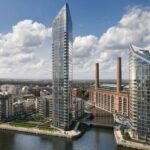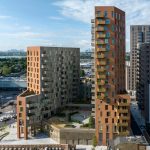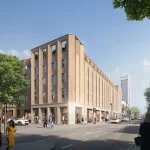Battersea Power Station Building News, Architect, Southwest London Masterplan Design Pictures
Battersea Power Station Building
Major London Redevelopment design by Rafael Viñoly Architects
14 Mar 2012
Battersea Power Station : Heritage and Regeneration
A conference organized by the Twentieth Century Society at the Building Centre, 26 Store Street, London WC1E 7BT. With support from the Building Centre Trust.
20 Apr 2012, 10.00-15.00
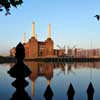
Battersea Power Station photograph © Nick Weall
Battersea Power Station Conference
The aim of the conference is to assist the public and media by presenting well-informed opinion about the development site in the light of new opportunities, with a focus on the retention of the Grade II* listed building.
Since its closure in the early 1980s and subsequent listing (now at Grade II*), Battersea Power Station has enlarged its hold on public affection, yet the several redevelopment schemes during this time have failed to proceed, and there has been talk of freeing up the site by demolishing its landmark building.
The Twentieth Century Society is holding the event, including key players in the current situation, to get a better understanding of the underlying dynamics and pressures of the development, with the aim of showing that demolition should not be considered as an option.
The event will provide a high level briefing and discussion forum on this case at a crucial moment in its history.
Morning
Gavin Stamp (journalist and historian) : Sir Giles Gilbert Scott and his Cathedral of Power
Keith Garner (architect, Battersea Power Station Community Group) : The story since 1980
Stuart Tappin (Structural Engineer, STAND) : The current condition of the building
Giles Dolphin (former Head of Planning Decisions, GLA) : Planning and transport issues
Marcus Binney : The Future of Battersea Power Station
Afternoon
Panel discussion, chaired by Loyd Grossman (Chair, Heritage Alliance) Marcus Binney (Chairman, SAVE and Times correspondent)
Nicholas Falk (planner and urbanist, founder URBED)
Sir Terry Farrell (architect and planner)
Paul Finch (Deputy Chair, Design Council/CABE)
Steve Kennard (former design director, Parkview – to be confirmed)
Ros Kerslake (Chief Executive, Prince’s Regeneration Trust)
Alan Powers (University of Greenwich, Chair of Twentieth Century Society)
Tickets £35 (students £25). Includes coffee, lunch and delegate information. Limited availability, early booking advised
In case of sell-out, additional tickets will be available for the afternoon session only at £15 (students £10, lunch not included)
Battersea Power Station Conference information received 140312
Battersea Power Station Apple Campus – Sep 2016
Battersea Power Station : main page, with images
Battersea Power Station London
Original structure : Giles Gilbert Scott
Design: Rafael Viñoly
18 Dec 2008
Battersea Power Station design evolves following consultation
The latest details of the design for preserving the iconic Battersea Power Station and creating a unique carbon neutral development were announced today. Treasury Holdings UK has responded to the results of the largest public consultation ever conducted in the UK on a development project. The Battersea Power Station scheme has evolved since the masterplan was launched in June 2008 and the formal planning application is still due to be submitted in Spring 2009.

Battersea Power Station photograph © Nick Weall
Rob Tincknell, Managing Director of Treasury Holdings UK, development manager for the owners Real Estate Opportunities Limited (“REO”), a London listed property company, said:
“We are creating a new heart for the Nine Elms area which is the single largest development site in central London and our scheme has evolved after listening and responding to the views of our key stakeholders and more than 15,000 visitors to our public exhibition. Nearly 70 per cent of respondents were supportive of our masterplan which is almost unprecedented in a public consultation exercise. We have heard what people like and what some did not like. We have maintained the overall concept but adjusted the mix and location of buildings on the Battersea Power Station site to respond to urban design issues and to reflect the views of the public and our stakeholders.”
Included in the latest Battersea Power Station scheme is a new one-acre performing arts amphitheatre for 2,000 people beneath the landmark Eco-Dome, which creates a naturally ventilated environment for the 1.3 million square feet of office space. It is anticipated that a resident orchestra or theatre company will be attracted to this unique indoor but outdoor venue.
There was overwhelming support from the public for the concept of delivering a carbon neutral development on the site. This will be delivered by the Eco-Dome under a transparent glass Chimney which draws air up through a campus of high quality naturally ventilated office buildings, and by a CCHP Energy Centre beneath the Power Station.
The frontage of the development on Battersea Park Road has been re-designed to make it more accessible and tie it into the local neighbourhood. The Eco-Dome has been relocated on the site nearer to the Thames and reduced in size and massing.
The height of the Battersea Power Station Chimney has been reduced to 250m in response to the technical requirements of a smaller Eco-Dome, to improve its appearance and to address concerns about its impact on views over the Houses of Parliament. The new Chimney is located in the shadow of the Victoria Tower from the majority of the view locations, and will read as a secondary form in the remaining views. The new design will ensure that the Chimney will be a stunning addition to London’s skyline and will be a symbol of the UK’s commitment to addressing the effects of climate change.
A new luxury hotel inside the refurbished Battersea Power Station will incorporate one of the largest ballrooms in London with a capacity for 2,000 guests. Other additions to the development, since the masterplan was announced in June, include a primary school, nursery, large health centre and a community centre.
The Battersea Power Station site will be home to around 7,000 people and up to 13,000 new jobs will be created. 3,500 homes will be built on the site and 2,500 jobs will be created during the construction phase. It is planned that construction work will start in 2012 and the development will be completed by 2020 – depending on the speed of the planning process.
Rob Tincknell said:
“The Eco-Dome and the Chimney will be a symbol of London and the UK’s commitment to mitigating the effects of climate change and will act as a signpost for the regenerated area of Nine Elms.
“We are very excited by our plans for the new amphitheatre where, under the cover of the Eco-Dome, 2,000 visitors will be able to watch performances sitting outdoors on natural grass while protected from the weather. It will be bigger and better than Broadgate Circle in the City.
“The mix and scale of the Battersea Power Station development is a reflection of views expressed during intensive consultations over the last six months. We are also very pleased that the US Embassy is considering locating to Nine Elms and we have taken this into account when adjusting the mix of the development.
“Over the last 12 months we have, in conjunction with Transport for London, conducted a series of studies into our proposal to extend the Tube to Battersea which all demonstrate that the extension is extremely viable, fundable and a very sensible solution to the transport problems of the area.”
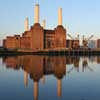
Battersea Power Station photograph © Nick Weall
REO is planning to spend £150 million on saving and repairing Sir Giles Gilbert Scott’s 1930s power station, with the key historic spaces retained and open to the public. It will spend a further £350m developing the Battersea Power Station building to incorporate the hotel, residential and retail accommodation. The project is fully funded through the planning phase which is likely to last for 1-2 years.
The £4bn Battersea Power Station development will comprise approximately 8 million square feet (750,000 square metres) of residential, office and retail space, a six acre public park and riverside walk.
The Battersea Power Station proposals include approximately 4 million square feet of residential, 900,000 square feet of retail, 1.3 million square feet of office, 1 million square feet of hotel and serviced apartments and 500,000 square feet of leisure, cultural and community accommodation.
Battersea Power Station will be used to generate electricity again for the first time in a quarter of a century, but from renewable sources rather than coal.
An underground Energy Centre will produce power with a new combined cooling, heat and power plant, but this time using biofuels, waste and other renewable energy sources. Two of the existing power station’s chimneys will be reused as flues for this new Energy Centre.
Treasury Holdings has a 67% interest in and is development adviser to REO, a property company listed in London, Dublin and the Channel Islands. Treasury operates in Europe, China and Russia and manages property worth more than €5 billion. It manages an associated company, China Real Estate Opportunities, which is the biggest western real estate investor in China.
Rafael Vinoly Architects, based in New York with affiliate offices in London and Los Angeles is internationally known for its critically acclaimed architectural projects. The firm focuses on maximising the opportunity for civic investment across diverse building typologies, employing structural originality that transcends the passing fads of architectural movements.
Over the last quarter century, the firm’s work has included master planning, laboratories, museums, academic, healthcare, commercial, residential, and industrial developments, as well as several initiatives involving the restoration of historic buildings with significant architectural import. Its landmark cultural and civic complexes include the Tokyo International Forum, Jazz at the Lincoln Centre in New York; the Kimmel Center for the Performing Arts in Philadelphia; and the David D. Lawrence Convention Center in Pittsburgh. RVA also designed the new Curve theatre and performing arts centre which recently opened in Leicester.
The six key objectives for the development which were announced in June have been maintained as follows:
The sensitive regeneration of Battersea Power Station
The creation of a zero carbon environment
The delivery of a sustainable mixed-use development which will ensure marketability and strong demand
To act as a catalyst for regeneration of the Nine Elms Corridor
To ensure that the project is totally deliverable
To facilitate a sustainable public transport solution
Battersea Power Station Redevelopment architect : Rafael Viñoly
Location: 188 Kirtling Street, Battersea, London, England, UK
London Buildings
Contemporary London Architecture
London Architecture Designs – chronological list
London Architecture Tours by e-architect
Battersea Power Station Designs
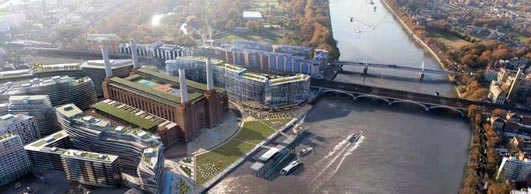
picture of the Battersea Power Station proposals
Battersea Power Station Architect : Giles Gilbert Scott
Also by Rafael Viñoly in London : Walkie Talkie building
Battersea Power Station redevelopment previous architect – Grimshaw Associates
Comments / photos for Battersea Power Station Architecture page welcome
Website: https://batterseapowerstation.co.uk/


